What a day today. I started off my morning talking about 30 Mosques on the Brian Lehrer show on NPR. We had a great conversation and hope you enjoy it.
Aman Ali co-author of the blog 30 Mosques in 30 Days, who is visiting a different New York mosque each night of Ramadan, shares what he’s learned about Muslim New York, hospitality and worship.
For the rest of this journey, I will be Bassam-less because he is in Texas spending the last remaining days of Ramadan with his family. So tonight, I visited Masjid El-Ber in Queens. I had heard of this place before but didn’t know much about it. But as soon as I pulled up to the place, I was floored. Check out the geometric marble patterns on the building, one of the most simple yet elegant styles of Islamic art.
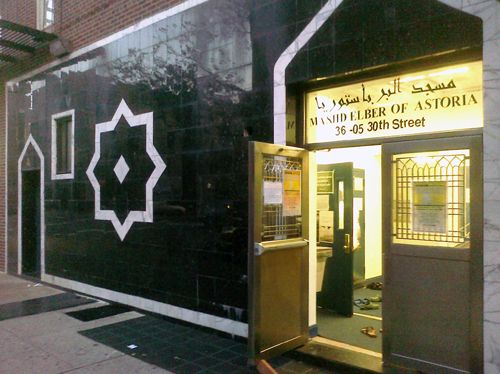
Simplicity is a rich vibe that circulates through this building. Inside is a simple prayer room with comfortable carpet and a few fans on the wall. This is a congregation that is predominantly Egyptian and Bengali, but there’s also a decent amount of Caribbeans and Moroccans. Before prayer, my buddy Sharaf Mowjood (the handsome devil in this pic below) and I sat back and observed the congregation as people were coming in.
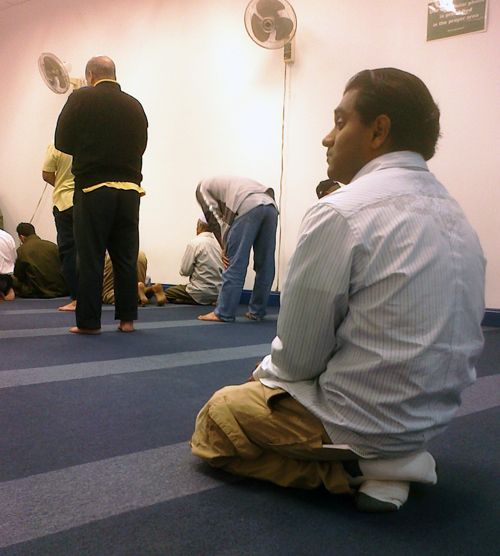
They gave the call to prayer, signaling it was time to break our fast. Once again we rocked it old school, dates with a glass of milk.
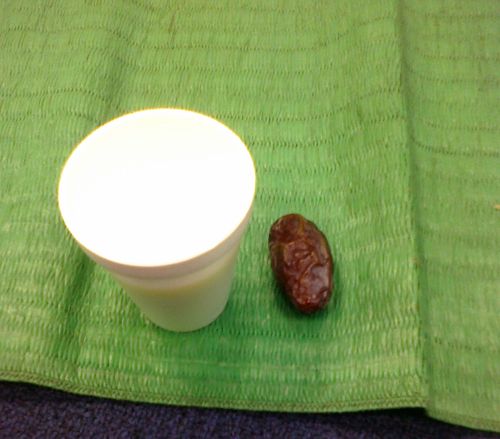
After we broke our fast and prayed, we sat among the brothers and patiently waited for the food to be served. For dinner we had Egyptian style food. It was sliced lamb over seasoned potatoes, salad, pita bread and a banana.
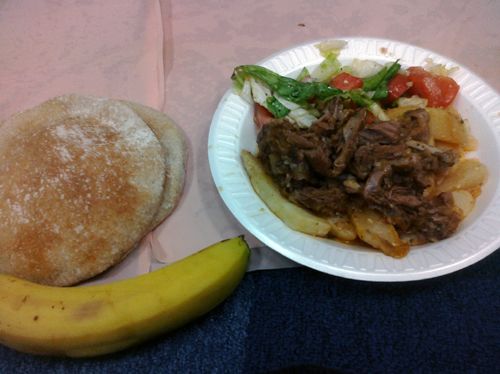
During dinner, Sharaf and I chatted with some of the brothers sitting nearby who told us a little bit about the history of the mosque. Apparently Masjid El-Ber has been in the neighborhood for well over 25 years. Now when I first heard that, initially I thought “Wow, 25 years, and they haven’t done any expanding?”
But then I thought about it. A mosque should cater to the needs of the local community. Even though the mosque has been around so long, maybe all the people need is a simple place to pray and gather. I looked around and saw people from all over the world coming in cracking jokes among one another. A litmus test I use to see if a mosque is serving the needs of a community, is checking to see if people are smiling. Masjid El-Ber passes with flying colors.
I was asked to not take pictures while people were eating because some of the people were self conscious. But I sat next to a person from the Caribbean island of Saint Martin named Mutassem. I can’t remember how the discussion came up, but we talked about how we both don’t like dogs.
Me, I am terrified of dogs. I’ve spent 2-3 years studying judo and have had knives pulled on me growing up, but if I see a poodle walking down the street, I turn into a screaming Miss Teen USA in about .3 seconds. So I asked Mutassem if he was afraid of them too, hoping he could comfort me with some solidarity. He laughed and said “No man, I just don’t like them licking me.” If there only was someone else in the world that’s as big a sissie as I am.
After we ate dinner, Sharaf and I went to Brooklyn to meet Tanzila Ahmed, one of his friends in who was in town visiting from Los Angeles. I didn’t formally introduce who I was and she began to tell Sharaf “So have you heard of this cool blog called 30 Mosques???”
I began to laugh and said “Umm hi, that’s me in the drawing.” Apparently she is a blogger for Sepia Mutiny, a South Asian site that wrote a nice post about us that brought a lot of new visitors to our blog. Small world, eh?
Tanzila was in town to check out this band called the Kominas, a group that has been dubbed as a Muslim punk band. I missed their performance, but I chatted with one of the band members after named Basim Usmani. He’s the first Pakistani man I’ve ever met with a purple mohawk. You can’t see it in the picture, but he’s wearing a lungee (or as I call it, “the South Asian man-skirt.”)
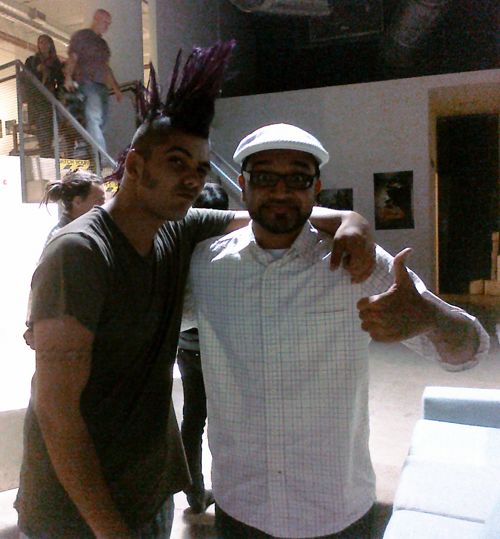
I have heard of the Kominas from friends before – most of the comments were strongly negative. But I always like to meet people with an open mind. I was curious to learn more about Basim. He grew up in Lahore, Pakistan and moved to Boston in the late 1990s. How on Earth did someone who was born and raised in Pakistan get involved in the punk scene? I had to know.
He told me that when he moved to America, the kids in the punk scene in Boston were the only ones that didn’t make fun of him for having a foreign accent. Immediately we bonded. Sure I’m clearly not a punk rocker, nor do I have an accent, but I can totally relate to feeling like an outsider in school. I think many Muslims can.
I went to elementary school around the time the Alladin movie came out, so I’d constantly get asked if I owned a magic carpet (I always quipped back with “No, I haven’t gotten my learner’s permit yet.”). But I never let that teasing get to me, and neither did Basim. The two of us grew up quite comfortable in our own respective identities, proud of who we are and where we come from. It’s interesting, aside from the people we were talking to tonight, just about everyone there seemed like a cookie-cutter hipster with skinny jeans, plain white t-shirts and Starbucks frappuccinos. And Basim, a towering Pakistani man with a purple mohawk and a man-skirt , seemed like the most genuine down to earth person in the entire room.
It’s easy to slam a place or someone based on a first glance. But take some time and approach forming your impressions with an open mind, and you’ll quickly see the beauty you overlooked from that glance.